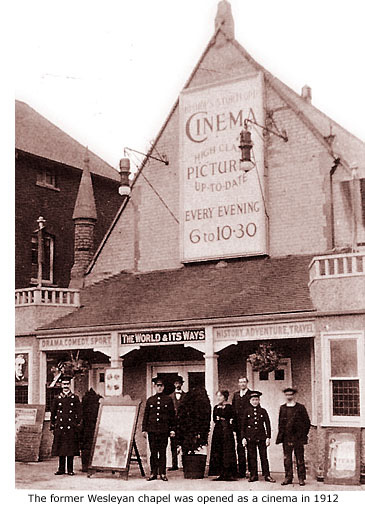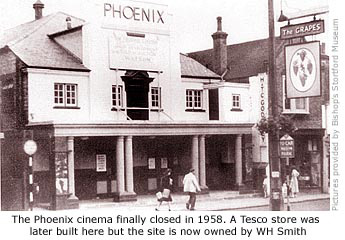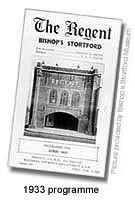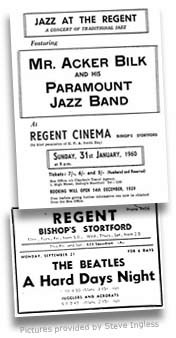|
|
|
 |
|
|
|
|
|
|
|
Cinemas
|
|
 When the new Cineworld six-screen cinema opened in the leisure complex at Anchor Street in December 2000, Stortfordians were once again able to visit a local cinema for the first time since 1977. By contrast, within the short space of twenty years early in the last century, a far smaller population had enjoyed the choice of visiting two cinemas in South Street. When the new Cineworld six-screen cinema opened in the leisure complex at Anchor Street in December 2000, Stortfordians were once again able to visit a local cinema for the first time since 1977. By contrast, within the short space of twenty years early in the last century, a far smaller population had enjoyed the choice of visiting two cinemas in South Street.
The man largely responsible for this was Ernest Edward Smith, whose family was at the centre of the town’s cinematic history for 50 years. In 1978 his grandson, Joe G. Smith, published The Story of Bishop’s Stortford’s Cinema, and it is from his book that most of the following text is drawn.
After the birth of the British Cinema in the 1890s some of the earliest short films may well have been shown in local halls or clubs, but in 1911 a race was on to complete the town’s first cinema. While Bishop’s Stortford Cinema Ltd were busy converting the old Wesleyan chapel at No 1 South Street (now the site of WH Smiths), another concern was building the Empire Picture Palace at No 20 South Street next to the Working Men’s Club. The former won the race and ‘The Cinema’ opened on 10 February 1912. It was, by all accounts, a quiet and private affair with admission that evening by invitation only.
In complete contrast, the opening of the Empire a few weeks later on 25 March was a much livelier event. The town band played, three films were shown, and the entire days takings of £5. 13s. 9d. (£5. 68) were donated to the Bishop’s Stortford Hospital. But despite the initial publicity, and a small fortune spent on weekly advertising, the Empire wasn’t successful and closed within three years of opening.
In 1914, extensive alterations were made to The Cinema that included a balcony and 100 additional seats, and two years later Mr Smith, a former barber and owner of the cinema in Saffron Waldon, stepped in and bought it.
 To insure The Cinema stayed ahead of any future competition he paid Alfred Slapps Barrett, the owner of the land on which the Empire stood, a weekly sum of one pound not to re-open. This ‘agreement’ was abided by, although the building was kept intact until after the Second World War when it was then used as a garage by the owner of a local firm and, later, by Clement Joscelyne as a furniture store. To insure The Cinema stayed ahead of any future competition he paid Alfred Slapps Barrett, the owner of the land on which the Empire stood, a weekly sum of one pound not to re-open. This ‘agreement’ was abided by, although the building was kept intact until after the Second World War when it was then used as a garage by the owner of a local firm and, later, by Clement Joscelyne as a furniture store.
|
|
Throughout this time the two small shops originally built on either side of the Empire’s main entrance, remained open. One was a hairdressing salon the other a sweet shop – the latter owned by George Wilson who later moved his business to a shop in Bridge Street (See Guide 1). The small premises then became a shoe repairers, and remains as such to this day. The other shop has long since gone and Burtons and Dorothy Perkins currently occupy the Empire’s former site.
After serving with the army in the First World War, Ernest Smith returned to Bishop’s Stortford in 1918 and set about further modification of The Cinema. This he re-opened the following year, putting on live shows as well as films. Early silent movies were always accompanied by a resident pianist, but later a device called a panotrope was installed which, in theory, synchronised music with films. In practice this was not always the case, but after experimentation with talking films in the 1920s finally proved successful, the first ‘talkie’ to be screened at The Cinema was Love Parade – starring Maurice Chevalier – on 9 February 1931.
The Cinema’s popularity was such that in 1929 Mr Smith bought a large plot of land opposite the old Empire on which to build a second, more up to date cinema. Designed by E.M. Allen-Hallett and built by local builder F. Cannon & Son, it was named the Regent and officially opened on 9 November 1931 by local MP, Rear Admiral Murray Sueter.
|
|
 Compared to The Cinema, or ‘flea pit’ as it was more popularly known, the Regent was luxurious and held a capacity audience of 999 people (1000 seats would have involved extra taxation). But having built his modern cinema Mr Smith then worried that the public would find it far too plush and want to return to ‘flea pit’, so to alleviate his fears he closed The Cinema the following year. Compared to The Cinema, or ‘flea pit’ as it was more popularly known, the Regent was luxurious and held a capacity audience of 999 people (1000 seats would have involved extra taxation). But having built his modern cinema Mr Smith then worried that the public would find it far too plush and want to return to ‘flea pit’, so to alleviate his fears he closed The Cinema the following year.
He needn’t have worried. The Regent quickly established itself as a popular venue, and with audiences continually rising he then refurbished the old cinema and reopened it in 1935 as The Phoenix. It didn’t exactly rise from the ashes but it did rise anew from the remains of the old cinema. Now with seating for 500, it also featured the added novelty of double seats in the back row for young lovers – cinemas at that time being the place where most couples did their courting! And unlike today’s standard priced tickets, seats were valued according to quality and positioning – the cheaper seats being in the stalls and close to the screen. Once inside though, it was possible to watch a film several times for the original admission price.
|
|
 At the outbreak of war in 1939 the government closed all cinemas nationwide, but very soon re-opened them again when it was realised they would be a moral booster. The town’s cinemas were certainly popular with the American forces stationed here, and the Regent put on occasional Sunday concerts in aid of charity. Stars that appeared included Cyril Fletcher, Harry Champion and a young Petula Clark. At the outbreak of war in 1939 the government closed all cinemas nationwide, but very soon re-opened them again when it was realised they would be a moral booster. The town’s cinemas were certainly popular with the American forces stationed here, and the Regent put on occasional Sunday concerts in aid of charity. Stars that appeared included Cyril Fletcher, Harry Champion and a young Petula Clark.
After the war both cinemas continued to show two films per week, the Phoenix playing mostly popular repeats and horror movies, and the Regent showing the latest releases. One notably successful film in 1948 was For Whom the Bell Tolls, which ran for a full week – a week being 6 days at that time because cinemas weren’t allowed to open on a Sunday. The previous year this fact had prompted local discussion but was strongly opposed by the Church. A subsequent poll of the town’s population recorded an overwhelming vote against Sunday opening.
When Mr Smith died in 1948, aged 76, his family continued to run both cinemas but by the 1950s, long before television intervened, audiences began to fall and it soon became apparent that the Phoenix was surplus to requirements. It closed on 3 May 1958, the last film shown being the X-rated Crime in the Streets starring James Whitmore.
In 1965 the Smith family sold the Regent to the Granada chain, although it retained its name until the official opening on 30 January 1967. A rather grand affair, it was attended by representatives of several film companies and three major stars of the time – Dickie Henderson, Rita Tushingham and Jess Conrad. The first film to be shown was My Fair Lady, promoted by the Town Band who marched up and down South Street playing a selection of tunes from the film.
The arrival of the ‘Swinging Sixties’ brought about a dramatic change in social attitudes and it wasn’t long before the topic of Sunday opening was raised once again. This time the Church agreed not to oppose the plan and at a public meeting in December 1965, attended by just 35 people, a vote in favour of the proposal was carried. On 26 June 1966 the Regent (as it still was at that time) opened its doors on a Sunday for the very first time.
The Granada continued to show a varied range of films in the hope of capturing a wide audience, but all to no avail. With the introduction of colour television in the early 1970s and the later advent of the video recorder, people preferred to watch entertainment in the comfort of their own homes and cinemas throughout the country soon became uneconomical to run.
An application to close the Granada in 1973 was rejected by the local council, but three years later permission was granted to convert it into a Bingo hall. The last film to be shown was Grizzly – described as Jaws on land – and the cinema closed for good on 22 January 1977. The Bingo hall survived until the early 1980s when the land on which it stood was then sold to Marks & Spencer who built their store in 1986. MORE PICTURES
|
|
|
|
|
|
[ BACK TO TOP ] |
|
|
|
|
|
|
|
|
|



 When the new Cineworld six-screen cinema opened in the leisure complex at Anchor Street in December 2000, Stortfordians were once again able to visit a local cinema for the first time since 1977. By contrast, within the short space of twenty years early in the last century, a far smaller population had enjoyed the choice of visiting two cinemas in South Street.
When the new Cineworld six-screen cinema opened in the leisure complex at Anchor Street in December 2000, Stortfordians were once again able to visit a local cinema for the first time since 1977. By contrast, within the short space of twenty years early in the last century, a far smaller population had enjoyed the choice of visiting two cinemas in South Street. To insure The Cinema stayed ahead of any future competition he paid Alfred Slapps Barrett, the owner of the land on which the Empire stood, a weekly sum of one pound not to re-open. This ‘agreement’ was abided by, although the building was kept intact until after the Second World War when it was then used as a garage by the owner of a local firm and, later, by Clement Joscelyne as a furniture store.
To insure The Cinema stayed ahead of any future competition he paid Alfred Slapps Barrett, the owner of the land on which the Empire stood, a weekly sum of one pound not to re-open. This ‘agreement’ was abided by, although the building was kept intact until after the Second World War when it was then used as a garage by the owner of a local firm and, later, by Clement Joscelyne as a furniture store. Compared to The Cinema, or ‘flea pit’ as it was more popularly known, the Regent was luxurious and held a capacity audience of 999 people (1000 seats would have involved extra taxation). But having built his modern cinema Mr Smith then worried that the public would find it far too plush and want to return to ‘flea pit’, so to alleviate his fears he closed The Cinema the following year.
Compared to The Cinema, or ‘flea pit’ as it was more popularly known, the Regent was luxurious and held a capacity audience of 999 people (1000 seats would have involved extra taxation). But having built his modern cinema Mr Smith then worried that the public would find it far too plush and want to return to ‘flea pit’, so to alleviate his fears he closed The Cinema the following year. At the outbreak of war in 1939 the government closed all cinemas nationwide, but very soon re-opened them again when it was realised they would be a moral booster. The town’s cinemas were certainly popular with the American forces stationed here, and the Regent put on occasional Sunday concerts in aid of charity. Stars that appeared included Cyril Fletcher, Harry Champion and a young Petula Clark.
At the outbreak of war in 1939 the government closed all cinemas nationwide, but very soon re-opened them again when it was realised they would be a moral booster. The town’s cinemas were certainly popular with the American forces stationed here, and the Regent put on occasional Sunday concerts in aid of charity. Stars that appeared included Cyril Fletcher, Harry Champion and a young Petula Clark.